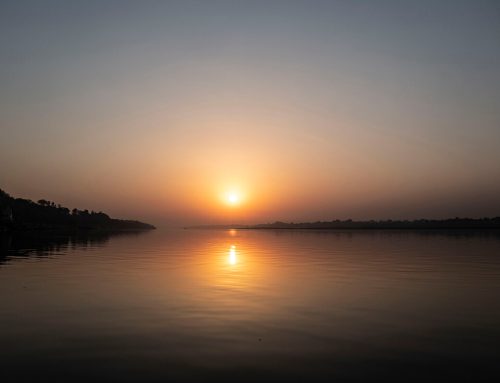My pilgrimage to Shakti Peeths in the legendary Tantric heartland of West Bengal
by Heather Elton
Pilgrimage is an important part of my spiritual path and I try to go on a yatra whenever possible. Over the past decade, I’ve traveled throughout India to places like Tiruvannamalai in Tamil Nadu, Kerala from top to bottom, to Mysore and Goa in South India, to Orissa and Varanasi further north, and on the Buddhist Trail to places like Bodhgaya, Rajgir, Dharamsala, from Manali to Leh, Darjeeling to Sikkim, and finally up into Nepal where I now spend a few months every year. I’ve done various sadhanas to cultivate bhakti towards deities from both Hindu and Buddhist traditions, from Shiva to Shakyamuni Buddha, Padmasambhava, Avalokitesvara and Vajrasattva. I’ve followed in the footsteps of Guru Rinpoche through the Upper Mustang Valley in Nepal along the route he took to spread the tantric Buddhist Vajrayana teachings in Tibet. Even though I’m a Nath yogini and belong to the Natesvari family, or panth, that embraces a synthesis of masculine and feminine energies—of Shiva and Shakti—I realize I’ve been focusing on male deities, ignoring my feminine side. It’s time to embrace the Goddess, the Mother. Pilgrimage is about transformation and I hope my journey will to take me to the heart of the Mother.
I decide the best place for this is in the tantric heartland of West Bengal. I want to experience the energy of Devi in the sacred geometry, the contours of the landscape, and places that have been associated with the Goddess throughout the ages—axis mundis—where devotees can easily communicate with the divine. The ultimate destinations of my sadhana are the Shakti Peeths, the auspicious places where parts of the Devi fell to earth. I want to have darshan of the goddess and in doing so have her reveal the feminine within me.
Jai Ma!
Above, Hand-carved yogini on a wooden lintel in the Royal Palace, Patan Durbar Square. ©Heather Elton
Devi is the Sanskrit word for Goddess and means “heavenly, Divine, anything of excellence.” The title Devi, or Mata, refers to the Goddess as the Divine Mother in Hinduism. Devi has been known by thousands of names, names that refer both to the Absolute, like Mahadevi and Adi Parashakti, and to specific female deities like Durga, Saraswati, Lakshmi, Parvati, Sati and Kali, to name a few. Every village in India has its own unique Brahma Devi. Some manifestations of Ma have a thousand names each. Devi often appears with her male counterpart—Parvati with Shiva in Shaivism, Saraswati with Brahma in Brahmanism, and Lakshmi with Vishnu in Vaishnavism. In addition to the pantheon of individual goddesses, there are groups of goddesses like the Matrikas, Navadurgas and Mahavidyas. There is a group of 64, sometimes 81, tantric devis—yoginis—who are devotees and attendants of Durga, and there are many anthropomorphic goddesses who remind us to examine what is real and what is illusory.
Goddesses come in all forms and sizes from the fair-skinned and demure Gauri, with curvaceous hips and full breasts, to the ferocious emaciated crone, Chamundi, who lives in the cremation grounds with ghouls and predatory animals like jackals and vultures.
Above, Kali and Durga slay the evil Buffalo Demon. ©Heather Elton
Durga is the fierce warrioress who rode her lion into battle at the request of the male gods in a time of crisis, to slay the evil Buffalo Demon who was threatening to destroy the world. When things get rough, Kali Ma appears as the terrifying dark-skinned goddess with wild hair, blood-dripping fangs, a skirt of human arms and a necklace of skulls, her extended tongue sucking up the blood from the battlefield in an act of compassion.
Each goddess is depicted either standing or seated on her special animal mount or vahana that transports her through the various realms of consciousness. You can identify each goddess by her particular stance and mudras (hand gestures). The same goddess can have a different number of arms; Durga is depicted in her two-armed form or 18-armed, or anything in between. Her various hands hold magical tools that are symbols to discern her identity and powers. The more arms she has the more powerful she becomes. Each manifestation of the goddess also comes with a mantra and a yantra. The proliferation of forms and names for Devi can be confusing. I remind myself to keep it simple. ALL the Hindu goddesses are manifestations of one goddess, Devi Durga. Even if she has 108 forms.
Goddesses come in all forms and sizes from the fair-skinned and demure Gauri, with curvaceous hips and full breasts, to the ferocious emaciated crone, Chamundi, who lives in the cremation grounds with ghouls and predatory animals like jackals and vultures.
Yogini or Dakini (Skydancer) cults became popular during the tantric era in medieval India and might be a continuation of the group of goddesses known as Matrikas, who appear in the earliest texts such as the Mahabharata and various Puranas. Hindu and Buddhist texts have mythologized yoginis as frightening, untameable women with uncontrollable sexuality, the opposite of the docile and respectful daughter, sister or wife. The yogini is the archetypal dangerous female ‘other’, associated with the darker or more wrathful manifestations of the goddess expressed through extreme and unorthodox behavior and terrifying appearances. Wild, unkempt hair, an enigmatic smile with protruding fangs and a third eye on the forehead all suggest danger, yet she is the compassionate mother. Her naked body is draped in animal skins or adorned with bone ornaments; she is often garlanded with a mala of severed human heads, holds a human skull (kapala) for drinking blood or amrita (nectar of immortality), and wears an animal head that points to the shamanic roots of the tradition. Names like Pretavahini (Corpse Rider), Yamaduti (God of Death’s Messenger) Bhayankari (Fearsome One) and Narabhojini (Cannibal) reflect the ferociousness of the yoginis and might explain why they have been feared throughout history.

Above, Kali steps on her husband, Shiva, after slaying the Buffalo Demon.
But who are these women described as crones, whores, blood-thirsty hags, with a volatile sexual power that threatened the social order? Around the same time in a different part of the world, their European sisters were persecuted and demonized as witches, burned at the stake by the Vatican. Perhaps this fear of yoginis reflects the cultural fears within orthodox Hindu culture of female sexuality and power? A sexually liberated woman is often seen as threatening because she is NOT in relation to a man. These female Tantrikas are also considered to be in the Nath tradition of the Kaula School of Yoga, under the tutelage of the mythic Bengali tantric Matsyendranath. Although it’s difficult to situate Matsyendranath in a historical framework, scholars have placed his birth around the 8th century C.E. In his important tantric treatise, Kaulajnananirnaya, Matsyendranath treats yoginis with respect and devotion, believing them to possess the intrinsic force of Shakti and to be the embodiment of the siddhis (sophisticated techniques to give supernatural powers and transcendental states).
But who are these women described as crones, whores, blood-thirsty hags, with a volatile sexual power that threatened the social order?
The Kaulajnananirnaya describes the yogic path outlined by Shiva to his consort. The teaching methodology is in the form of a dialogue between Bhairav, the fierce form of Shiva, and the Devi. In some tantras, the Devi actually teaches Shiva. Mysterious tantric practices, perform- ed in secrecy, navigate various realms of consciousness to determine what is real and what is a dream, going beyond this space-time continuum into more subtle realms, between form and formless. Bliss. Magic acoustic formulas are uttered, opening up portals to summon the deity. The vibrational sound frequency of the mantra is the body of the deity. Ancient yantra designs are downloaded by the sages and etched into the earth.

Above, Detail of yogini stone carving on Konark Sun Temple, Orissa, India. ©Heather Elton
Yoginis and dakinis appear in tantric sadhana as the mediators between realms of consciousness, helping to remove certain ‘veils’, or granthis, to prepare the physical and subtle body to receive kundalini or shakti energy. The subtle yogi body is the intersection between form and formless. Yoginis bring the formless into form. Dakinis bring the form back to formlessness. They conceal and reveal. Perhaps it’s more mundane and they simply help us work with afflicted emotions to transform them back into an unconditioned or unfabricated liberated state of mind. The iconography of the yogini temples helps us understand the blissful state of “emptiness” combined with desire.
Yoginis and dakinis appear in tantric sadhana as the mediators between realms of consciousness, helping to remove certain ‘veils’, or granthis, to prepare the physical and subtle body to receive kundalini or shakti energy.
The erotic sculptures give rise to a refined sense of desire (the vibration that comes before a thought). Ritual, invocation and worship of deities are not something outside ourselves, but exist within, as part of consciousness. The journey of the practitioner is about unraveling— deconditioning ourselves to understand who we really are. Wrathful deities exist to scare us away from entering altered states until we’re ready. They demand we take off the layers of our crustacean mind, conditioning passed down through generations, to clear our stain of perception and see through the veils of maya (illusion) that prevent us from seeing our true nature. Pure vision.
Above, Salabhanjika yakshis. Hoysala era sculpture, 12 C.E. Chennakeshava Temple, Belur, Karnataka, India.
Sculptures depicting stylized feminine figures grasping a branch of the sala tree. ©Heather Elton
The origins of goddess worship are obscured in history. It’s as elusive as the roots of Hatha Yoga with its nomadic and oral-based traditions passed from Guru to adept—little material culture and textual evidence exists. Some claim that the trading seals at Harappan and Mohenjo Daro, from the Indus Saraswati civilization (2500–1750 BCE) are evidence of goddess worship. One, in particular, that has a female shape under a tree and eight attendants is interpreted as early goddess worship. Another has a tiger and a female in a tree.

Above, Harrapan trading seal from the Indus Saraswati Civilisation.
This female goddess is known as a Yakshi, or Yakshini, and is an earth spirit, accepted as a symbol of fertility by Hindus, Buddhists and Jains. She shows up later to adorn the gate of the great stupa at Sanchi (3rd century BCE). Sculptures depict a yakshi as a beautiful and voluptuous woman in the three-bend pose (tribanga), bending at her neck, waist, and hips, standing under a tree with her upper hand grasping a tree branch and causing the tree to bear fruit simply by touching it with her foot. Her spherical breasts, narrow waist and wide child-bearing hips symbolize the fertility of the earth. Sculptures and rock carvings depicting the curvaceous form of the divine feminine have existed across time and cultures.

Above, Yakshi adorning the Sanchi stupa in 3 BCE.
Goddess worship exists in scriptures since the time of the Vedas. However, it wasn’t until the post-Vedic texts of the medieval era with Tantra and Shaivism that a major expansion in goddess mythology and literature occurred. The first reference to the Goddess can be found in the earliest text, the Rig Veda, which attributes the creation of the cosmos to the goddess Vac. Vac means “speech”,“word”or“voice”. The world was created through the vibration of sound. Vac is the supreme goddess, the creatrix, the Queen of all gods, the source of the cosmos and divine power. Even though Vac is about speech and the Vedas are shruti, or “heard into existence,” the Rishis “see” Vac by tapping into their inner vision. In the Riddle Hymn (RV 1.1 64 41-42) Vac is represented as a cow and the syllable she utters—ohmmm—sounds like a lactating cow mooing to her calf. From her breasts flow an inexhaustible supply of milk, the sustenance of life and the key to salvation. Vac is also considered to be an ancient model for Saraswati, the goddess of wisdom.
The Devi Sukta, another hymn in the Rig Veda (10.125.1-10.125.8), declares that the ultimate reality is the Goddess, equal to Brahman:
“I have created all worlds at my will
without being urged by any higher
Being and dwell within them. I per-
meate the earth and heaven and all
created entities with my greatness and
dwell in them as eternal and infinite
consciousness.”
In the Devi Bhagavata Purana (900-1400 C.E) everything begins with Adi Parashakti, or Adi Shakti. Adi means “first” and Para, “beyond”. Shakti means “Supreme Power”. When nothing existed, a light emerged in the darkness and took the form of Adi Shakti. Her first emanation was Ma Kushmanda (one of the Navadurgas) whose form is identical to Durga, with three eyes, trishul, shield, mace, bow, arrow, chakra, long sword, with one hand shown in abhaya mudra, and sitting on a lion. Kushmanda created the universe through her silent smile. She produced the Cosmic Egg, bringing light to the universe. Her luminosity gives the Sun its brightness.
When Ma Kushmanda opened her left eye, Maha Kali was born. She opened her right eye and Maha Saraswati was born. When she opened her third eye, Maha Lakshmi was born. These three main goddesses are married to Shiva, Brahma and Vishnu, the holy trinity of the Hindu pantheon of Gods. So, the great goddess precedes everything—Brahma the creator, Vishnu the sustainer and Shiva the destroyer, the time that spans between them and the space from where they evolved. Everything which exists in the universe comes from Adi Shakti, this central super goddess who is pure consciousness and bliss—primordial cosmic energy. She is the essence of all the non-dual tantric teachings. She is the Mother.
The word Durga is found in post-Vedic Sanskrit texts such as the Mahabharata (2.451) and the Ramayana (4.27.16), but these references have nothing todo with Durga as a demon-slaying goddess. This narrative came much later, in a section of the Markandeya Purana (400—600 C.E.) known as Durga Saptashati, Devi Mahatmya or Chandi Path, where Durga manifests as the supreme power and the creatrix of the universe. In Devi Mahatmya, Durga proclaims her pre-eminence as the Supreme Being. She says:
“I resemble in form Brahman,
From me emanates the world
which has the Spirit of Prakriti and Purusha,
I am empty and non-empty,
I am delight and non-delight,
I am knowledge and ignorance,
I am Brahman and not Brahman.”
In the Devi Upanishad (900-1400 C.E.), the goddess is thrust into her prominent role, equal to Brahman. Celestial beings ask Devi who she really is after proclaiming that she rules the world, blesses devotees with riches, and is the supreme deity to whom all worship is to be offered, and that she infuses Atman in every soul.
“Mahadevi (Great goddess)! Who
are you? What is your actual form?”
Sridevi answered thus, “I am indeed
the supreme Parabrahman. I emanate
this world, composed of Prakriti and
Purusha. I am the Shunya (emptiness)
and beyond the Shunya. This world is
both Sat (existent or true) as well as
Asat (non-existent or false). I am both
Ananda (bliss) and Anananda (mis-
ery). I am both Vijnana (knowledge)
as well as Avijnana (ignorance). I am
the one who is recognized as Brah-
man and also as not Brahman, or I
am the Brahman that everyone should
know and also the illusion. I am both
Panchikrita as well as Apanchikrita
Mahabhoota (I am of the forms of
all the elementals like air, water etc.
as well as non-elementals), I am the
entire visible world!”
Sridevi describes her incomprehensible form to destroy the ignorance of her devotees (the devas). In the Shakta and Shaiva traditions of tantra, Devi is the Divine Mother, the supreme being who represents the animating force of the universe. Without her Shakti energy, Shiva remains a shava, or corpse. One needs to understand that if anything exists, it’s ‘her’. Nothing exists other than Sridevi. She is the ONE and the many. She is the only ultimate truth.

Above, Durga in her 18-arm manifestation in a temple in Pharping, Nepal. ©Heather Elton.
Tantra and goddess worship can be seen like two entwining fish. If these secretive practices have existed since the earliest humans, they also have been driven underground by the dominant culture and the patriarchy. While there are a few references to tantra in the Vedas, mostly it was practiced by the tribal, indigenous and non-Vedic cultures. It’s important to remember that early yogic texts were written by Brahmins—priests who were high-caste, conservative men often associated with maintaining order in society. In the past ten years, there has been a shift in the interpretation of ancient texts. Instead of linguists who are mostly interested in Sanskrit texts, foreign scholars, female Indian scholars, and spiritual practitioners have been studying the deeper meaning of the tantric texts.
Tantra became popular during the 5th to 6th centuries C.E. due to an overemphasis on ‘elite thinking’ in Brahmanical India and ordinary people getting tired of being told what to do. Villagers and farmers didn’t really care if “everything is an illusion”. That didn’t help them if a sheep died giving birth or the harvest was eaten by locusts. One of the most dangerous things was the body. It was viewed as impure and even early hatha yogis practiced tapasya (austerities) to conquer the desires of their own bodies. Some still do. With tantra, instead of the body being viewed as something to get rid of, it was embraced, and in fact became a vehicle for liberation. But the extreme and unorthodox nature of tantric practice meant that the sadhaka(s) tended to be farmers, indigenous and low-caste people, people who were more concerned about their crops than Sanskrit liturgy.

A wrathful dakini in Vajrayana Buddhism.
At the heart of tantra, fierce yoginis merge with Shaivite siddhas—the Pashupatas—who are fond of skulls and live in cremation grounds. The last thing orthodox Brahmins would want to accept were naked, intoxicated, wild, undomesticated women who indulged in taboo and transgressional practices. It’s not surprising that these practices didn’t make it into the main Brahmanical texts.
The tantric movement gained momentum and by 1200 C.E., it became the most popular religion in India and everyone practiced it from peasants to royalty. Kings throughout Asia took tantric initiation. Alexis Sanderson writes in The Shaiva Age (2009):
The early medieval period, from
about 500 C.E. to 1300 C.E., saw
a decline in the role of sacrifice…
Kings continued to accept their role
as the guardians of the Brahmanical
order [but] their personal religious
commitment generally took the
form of Buddhism, Jainism, or,
more commonly, devotion to Shiva,
Vishnu, the Sun-God or the Goddess.

Above, The Goddess Bhairavi Devi in the cremation grounds. Metropolitan Museum of Art.
While all forms of the goddess still exist in India, over time, she has undergone a transformation from the wild, dark-skinned village goddess to a fair-skinned coy seductress, a demure, domesticated householder goddess. Her wild flying hair has been combed and her uncontrollable and uncontainable energy tamed. In the 10th century C.E. there was a shift away from the frightening kapalika, skull-bearing images, to the more erotic or mystical emanations of yoginis in the temples. Early indigenous or folk practices were incorporated into more orthodox religions. The original fearful deity has merged with a gentler and more modest Narayani. But all manifestations of the goddess are Durga. Regardless of the iconography, Shakti is the powerful, dynamic force that pervades all existence. Shiva is the Absolute—formlessness itself. He is invisible and it’s his dance with the Shakti that brings his energy and presence into form. The masculine is the container, the field, the one who holds space upon which the feminine Shakti is dancing. Like the Devi, tantra is the warp of a loom weaving diverse threads and seeing the essence, the unity behind it all.
Jai Ma!
Cover image, Taleju Bhawani at the Golden Gate in Bhaktapur Durbar Square. ©Heather Elton
Read Part Two of The Goddess Episodes – WHAT IS A SHAKTI PEETH?








